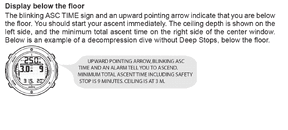MrsBBC
Contributor
Is that an older D4? I have a new D6i and in my manual it clearly shows the "stop" alert when the computer is telling you to make a RECOMMENDED or a MANDATORY safety stop. My manual indicates the only time I would get a "asc time" alert is when I go into a decompression dive (i.e., I stay down too deep for too long), so as others have said, you went into a decompression dive. However, you should also have seen the "stop" alert, which should disappear only after you make your safety stop. So I don't know why yours didn't. Can anybody answer that question? Other than maybe older versions of the D4 do not have this feature?
The ER will appear if you exceed the ceiling and you have 3 minutes to get back below the ceiling to complete your safety stop. Since you did not complete your safety stop, the computer went into permanent ER (i.e., 48 hours of ER display).
The Stop alert for the safety stop would not have shown because the 8 minute decompression stop was not completed. After completing the 8 minutes of deco the 3 minute stop would appear.
Because the dive was finished before completing the mandatory decompression stop (hence the lock out Error), clearly the safety stop was not made.
8 mins of deco, although not a lot of deco (assuming adequate gas), is a lot of deco if you do not understand how to operate your dive computer in deco.
'mandatory safety stop' is sunnto babble for a safety stop that suunto require you to complete or will penalise you for it. It is not a deco stop. Although I don't recall it ever happening to me, I see no reason why the mandatory safety stop could not follow a deco stop. But regardless, the computer does not error for missing a mandatory safety stop, only for not completing deco.





